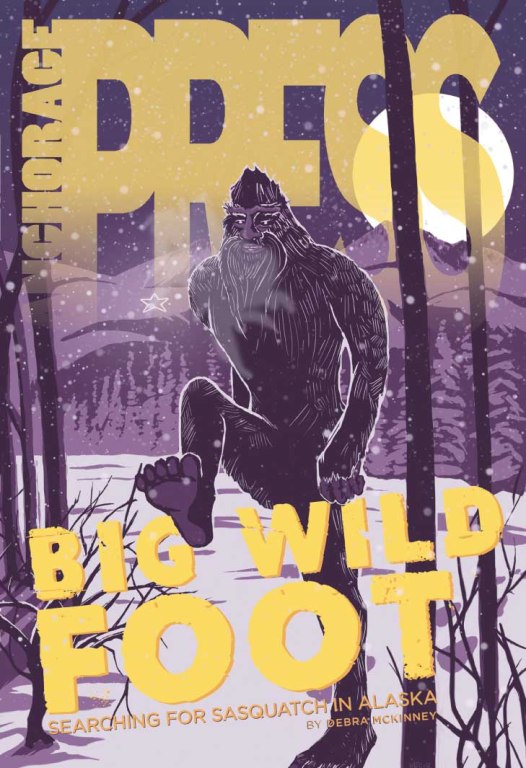Big Wild Foot
Posted by: Craig Woolheater on June 6th, 2016

Artwork by Nick Raffuse
Searching for Sasquatch in Alaska
No sooner was I asked to do story on Bigfoot in Alaska than I started hearing all kinds of things that made me realize I’m not getting out enough. Stories of a Jurassic Park-like creature with a 14-foot wingspan in the skies west of Dillingham. Of fresh Wooly Mammoth tracks in Denali National Park. Of a Velociraptor sighting at the Turnagain Pass outhouses.
Those I’ll leave to other inquiring minds. I was onto Bigfoot, and all I knew about this hairy bipedal cryptid I learned from standing in grocery store checkout lines: “Bigfoot Diet! He loses 150 pounds—It can work for you too!” This tabloid weight-loss program came with photos of a “before” Bigfoot at 800 pounds looking like he’d swallowed a wrecking ball and an “after” in a racy loincloth at a svelte 650. But I wasn’t fooled; no way was that the same Bigfoot.
According to a Chapman University survey, about 20 percent of Americans believe in Bigfoot. (That’s the same percentage of Republicans, according to Public Policy Polling, who believe Obama is the anti-Christ.) When the Bigfoot question is expanded from “real” to “probably real,” it’s more like 30 percent, an Angus Reid Public Opinion Poll tells us. If you believe in polls.
So that’s where I started—with a snarky attitude and the belief that Bigfoot was nothing more than a tabloid celebrity with a handful of believers incapable of holding a camera steady. I had no clue how real Bigfoot is to so many people from so many walks of life, nor how big Bigfoot is in Alaska.
Then I met Todd Rector, a Palmer father of two with a lifelong fascination with Bigfoot and a degree in cultural anthropology who warned me of all the crap out there, then directed me to two books he highly recommended: Make Prayers to the Raven, by Richard Nelson, the Sitka cultural anthropologist and host of the NPR radio program “Encounters,” whose book includes a section on what Koyukon people call Nik’inla’eena or, in English, the Woodsman.
The other was Raincoast Sasquatch, a collection of first- and second-hand stories, historical accounts and Native folklore from Yakutat to Puget Sound, by J. Robert Alley, a retired adjunct professor of anatomy and physiology at the University of Alaska Southeast who’s been researching Sasquatch for more than 40 years.
Rector told me of his own encounter while grouse hunting north of Fairbanks that will make my next berry-picking outing up that way nice and edgy, thank you very much.
Over the next few weeks, I read up, poked around the Net, visited websites, perused blogs, watched videos, heard recordings, talked to experts and listened to people’s stories. I discovered what a lot of people already know, that the Bigfoot/Sasquatch phenomenon is ginormous in this country. I checked my own beliefs at the door and passed through the portal into the wide world of Bigfoot, a complex and contentious world inhabited by skeptics and believers, hoaxsters and proselytes, boneheads in night-vision goggles hamming it up for reality TV shows and Ph.D scientists working to unravel the mystery. Like Jeff Meldrum, author of Sasquatch: Legend Meets Science, who examines evidence, from footprints to photographs, without imposing a conclusion.
The world of Bigfoot isn’t just about sightings and encounters. Enthusiasts discuss diet, behavior and habitat loss. They debate investigation and tracking techniques. They subscribe to Bigfoot Times, go to Bigfoot conventions and take Bigfoot-tracking vacations. Bigfoot, I learned, is an industry, with merchandise ranging from field gear and evidence collection kits, to “It’s Feeling Kind of Squatchy” T-shirts and Bigfoot Christmas cards, ornaments and wrapping paper.
“Brushes with Bigfoot that fall into the “encounters” category range from finding tracks way too big and far apart to be human, to the overwhelming feeling of being watched, to a horrific smell, a skunky, putridy, dirty-diapery, Superbowl-locker-roomy kind of smell.”
It’s also a world rife with controversy going well beyond truth versus fiction and why, if there’s all this alleged evidence—hair, scat and the like—hasn’t DNA testing proven the creature’s existence? Why, if there have been so many sightings and encounters, hasn’t anyone produced what Bigfooters call “the golden hair?” Since the world demands scientific rather than anecdotal proof, there’s an impassioned debate around whether—if the opportunity arises—to shoot or not to shoot. Several people claim to have had Bigfoot in their riflescopes, but couldn’t pull the trigger because it seemed too human.
Even what to call the hairy hominid is subject to debate.
Read the rest of the article here.
About Craig Woolheater
Co-founder of Cryptomundo in 2005.
I have appeared in or contributed to the following TV programs, documentaries and films:
OLN's Mysterious Encounters: "Caddo Critter", Southern Fried Bigfoot, Travel Channel's Weird Travels: "Bigfoot", History Channel's MonsterQuest: "Swamp Stalker", The Wild Man of the Navidad, Destination America's Monsters and Mysteries in America: Texas Terror - Lake Worth Monster, Animal Planet's Finding Bigfoot: Return to Boggy Creek and Beast of the Bayou.








